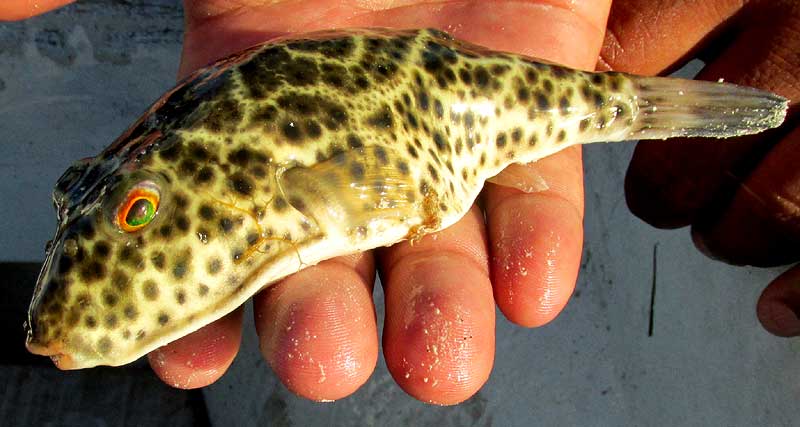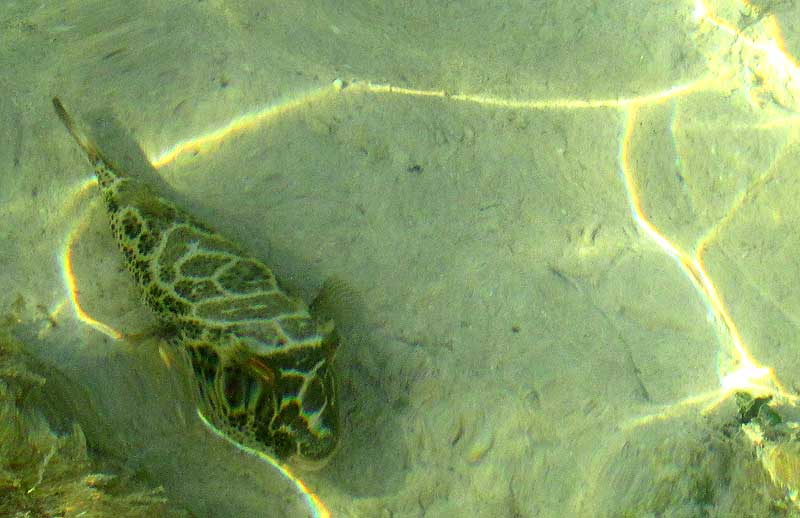Excerpts from Jim Conrad's
Naturalist Newsletter

from the March 15, 2015 Newsletter issued from Río Lagartos, on the Yucatan Peninsula's northern coast (~N21.60°, ~W88.16°), Yucatán state, MÉXICO
CHECKERED PUFFER
Rayo wanted to add something new to the aquarium so he got together some buckets and a toss-net, and invited me to come along. On his first toss he caught what's shown in his hand above moments before being returned to the water.
That's a Checkered Puffer, SPHOEROIDES TESTUDINEUS, listed in a recent study as the second-most numerically abundant fish species in Ría Lagartos Estuary. Also, Checkered Puffers were found to provide an astonishing 71.5% of the estuary's fish biomass, and the fish is one of five species in the estuary able to tolerate the least salty water. These observations are presented in a 2010 Spanish-language work by Peralta-Meixueiro et al, entitled "Evaluación Espacio-temporal de los Ensamblajes de Peces en el Sistema Lagunar de Ría Lagaratos, México."
So, Checkered Puffers definitely are among the most abundant and ecologically important fish species in the estuary, so it's no surprise that on Rayo's first net toss he got one. During subsequent tosses he netted several more, and all were returned to the water, regarded as too common to feature in an aquarium. Even I have grown accustomed to seeing them from day to day, for in shallow water just below the Malecón's wall they're commonly seen wandering by nonchalantly, and in tide waters flowing through culverts beneath the Malecón, Checkered Puffers often are visible "going with the flow." There's something about them almost creepily easy-going, self-confident and familiar.
Yet, they're curious little beings. They're called puffers because when attacked they puff up like balloons. Sometimes locals fishing from the Malecón's walls toss Checkered Puffers they catch onto the street to die, instead of back into the water, so sometimes puffers lie around looking like half-inflated footballs.
A 2012 study by Chi-Espínola and Vega-Cendejas found that Checkered Puffers in the Ría Lagartos Estuary throughout the year ate bivalves such as oysters, and gastropods such as sea snails, but largely shifted to aquatic vegetation during rainy periods and when it was windy.
And Checkered Puffer flesh can be toxic, which may explain their apparent nonchalantness in a predator-prey world. The toxins are in the fish's intestines, liver, skin and reproductive organs, which normally are discarded when a fish is cleaned, but the poison is so potent that it can contaminate the flesh during the clearing process. Eating Checkered Puffers has killed people. The poisoning is known appropriately as "puffer poisoning"; sometimes Checkered Puffer flesh is used to kill unwanted dogs and cats.
Checkered Puffers occur in inshore water and on rocky bottoms from Rhode Island on the US Atlantic coast south through the Gulf of Mexico and the Caribbean to southeastern Brazil.
Here we have three puffer species -- members of the genus Sphoeroides -- but the other two species are much less common, and I've not seen them.
from the March 22, 2015 Newsletter issued from Río Lagartos, on the Yucatan Peninsula's northern coast (~N21.60°, ~W88.16°), Yucatán state, MÉXICO
CHECKERED PUFFER IN ITS HABITAT
Above we show a Checkered Puffer caught by net and held in the hand, understandably looking a little put-out. This week during a flamingo-viewing trip during a low tide our boat passed through very clear, shallow water where hundreds of Checkered Puffers, seen individually and in small groups of ten or so, were clearly visible. Seeing so many, it was easy to believe that a study of the Reserve's fish found Checkered Puffers contributing 71.5% of the total fish biomass here. Below, a picture shows a puffer hanging at peace on the estuary floor:
